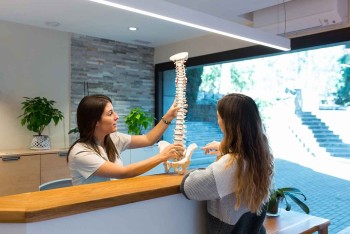
Cervical degenerative disc disease is a condition that affects the discs in your neck, which serve as cushions between the bones (vertebrae). Over time, these discs can wear down, leading to discomfort and pain. In this post, we’ll explore the symptoms, treatment options, and preventive measures to help manage cervical degenerative disc disease and prevent further complications.
Symptoms of Cervical Degenerative Disc Disease
By downloading the Digital Patient Chart mobile app you can better control your patient portal.
Symptoms can vary widely depending on the severity of the degeneration and how it impacts the surrounding nerves. Here are some of the most common signs:
- Neck pain
- Stiffness
- Headaches
- Radiating pain down the arms
- Numbness or tingling in arms and hands
- Weakness in the upper extremities
- Muscle tension
These symptoms can range from mild discomfort to severe pain, making everyday activities like driving or even holding objects difficult. If you’re experiencing any of these symptoms, it’s important to consult with your healthcare provider for an accurate diagnosis and a tailored treatment plan.
Diagnosing Cervical Degenerative Disc Disease
Diagnosis typically begins with a thorough medical history and physical examination. Imaging tests such as X-rays, MRIs, or CT scans are often ordered to assess the health of your spine. While X-rays can reveal bone changes, they may not detect early disc damage, which is where MRIs or CT scans come in handy. These advanced imaging techniques provide a detailed view of the discs and any associated issues, such as herniation or nerve compression.
Treatment Options for Cervical Degenerative Disc Disease
There are a variety of treatments available, ranging from conservative approaches to surgical interventions:
Conservative Treatments: For mild to moderate cases, non-invasive treatments like physical therapy, over-the-counter pain relievers, and applying ice can help manage symptoms. Steroid injections may also be used to reduce inflammation and pain.
Surgical Treatments: When conservative treatments fail, surgery may be necessary. The most common procedure is an Anterior Cervical Discectomy and Fusion (ACDF), where the affected disc is removed and the bones are fused to stabilize the spine. Other surgeries, such as disc replacement or laminectomy, may also be considered based on the patient’s needs.
Preventing Cervical Degenerative Disc Disease
While degenerative disc disease is often related to the aging process, there are steps you can take to slow its progression and reduce your risk:
- Maintain good posture: Proper alignment while sitting, standing, or working can reduce stress on the neck.
- Stay active: Regular exercise helps keep your spine strong and flexible.
- Healthy habits: Avoid smoking, which can accelerate disc degeneration, and maintain a healthy weight to reduce strain on your spine.
- Take breaks: If your job involves repetitive motions or extended periods of sitting, take frequent breaks to stretch and move your neck.
The Role of Upper Cervical Care
One of the most effective ways to manage cervical degenerative disc disease is through proper spinal alignment. When the spine is out of alignment, it places extra stress on the discs, accelerating their wear and tear. Upper cervical care, a specific type of chiropractic treatment, focuses on the top two bones in the spine. Misalignment in this area can lead to pressure on the discs and nerves, exacerbating degenerative disc disease.
Upper cervical chiropractors use gentle adjustments to realign the spine, relieve pressure on the nerves, and restore balance. This non-invasive approach can help reduce pain and prevent further degeneration. If you’re experiencing symptoms of cervical degenerative disc disease, consulting with an upper cervical chiropractor may offer the relief you’ve been seeking.
Conclusion
Cervical degenerative disc disease is a condition that can impact daily life, but there are effective treatments available to manage symptoms and slow its progression. From physical therapy to advanced chiropractic care, you have options for relief. Remember to maintain good posture, stay active, and consult with a healthcare professional if you notice any symptoms.









Leave a comment